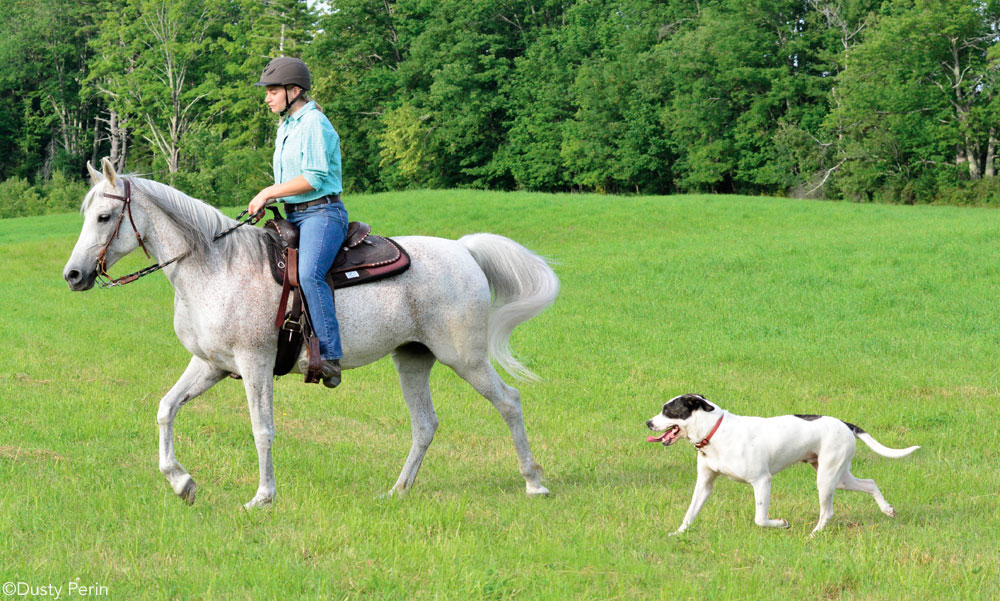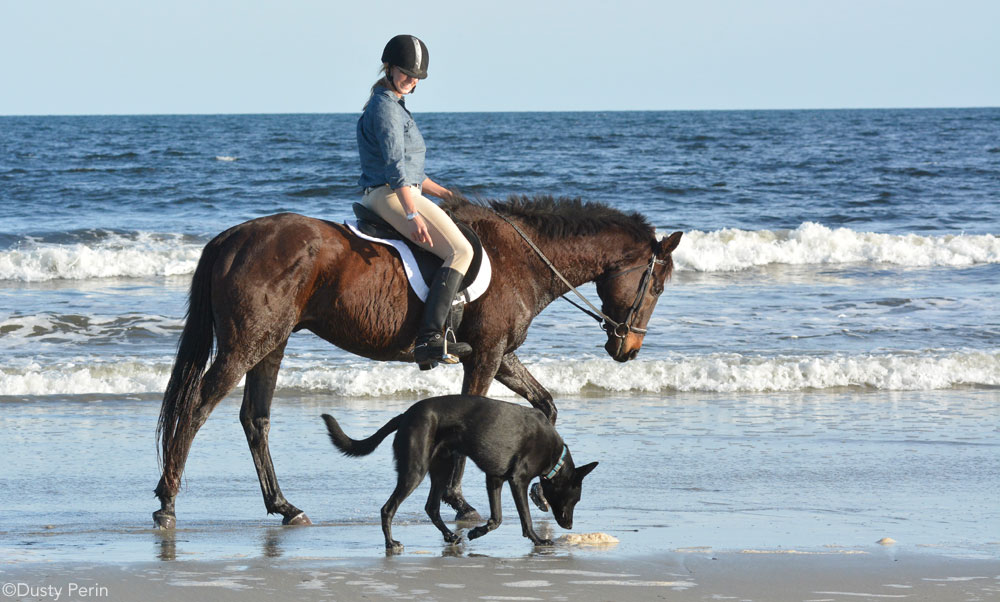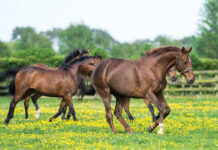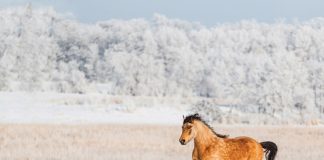When I look back over my life with horses, I can honestly say my happiest riding days were the ones I spent trail riding with my dog. I was a long distance rider—heavily into competitive trail—and the best way to get a horse fit meant hours in the saddle doing miles and miles of solo riding.

Trail dogs are common on ranches and working farms, but less so in areas where people trail ride for pleasure. But a good trail dog is worth his weight in gold, especially if you ride solo. Your horse and dog can develop a wonderful bond and draw confidence from the other in the face of scary circumstances.
Essential Training Commands
Creating a trail dog is probably going to be easier if you start with a puppy. All good dogs need to be socialized properly around people, other dogs, livestock, and new places with different sights, sounds and smells. Some mature dogs that have had a variety of experiences may adjust well to the barn, while others may find it overwhelming. If you have an adult dog, you will just have to try it, proceed with caution, and see what happens.
Before you mount up, your dog needs a reliable level of basic skills with an excellent recall. Just like training a horse, everything starts with solid ground work and a foundation established at home before venturing out. Your dog should be able to follow and respond to a minimum of the following six commands. If you don’t have experience with dog training, get help from a professional. Teaching it right the first time is much easier than correcting a mistake later.
- Come: The most important word in a dog’s vocabulary should be the recall command. It’s critically important on the trail because you don’t know what distractions your dog will find. Keeping treats in your pocket to reward your dog helps create a solid recall.
- Stay: It doesn’t need to be a sit-stay, but for safety’s sake, you need to be able to stop your dog in his tracks. I consider the stay to be equally as important as the recall. If you need to test out uncertain terrain or check the depth of a river before you cross, having your dog stay and wait in a safe area is a top priority.
- Leave it: Dogs can always find items of interest on the trail, but they won’t necessarily be good for him. Skunks, porcupines, snapping turtles, snakes, and dead things are just a few examples of why a well-ingrained “leave it” command is important.
- Go ahead: When you are out on the trail, it is much easier to stay focused on your horse and riding if you can keep the dog in your line of sight by sending him ahead of you off to one side. This is especially useful at the beginning of your ride when both dog and horse are full of energy.
- Go behind: This keeps the dog following behind your horse at a safe distance. It’s useful on narrow trails where you don’t want your dog to slow down in front of you and get stepped on. Tired dogs are usually quite happy to go behind the horse. You will need to check over your shoulder more frequently to check if the dog is falling further behind. If he is, it’s time for the final command.
- Rest: Dogs will tire before a horse, they just don’t want to admit it. You need to have a rest command that allows your dog to either sit or lie down and take a break without being anxious that you will be leaving soon.

Ready to Ride
Once you have perfected your ground skills, mount up and perfect them once again in the ring from the back of your horse. You should also practice mounted with your dog on a leash. This might sound ridiculous, but a well-trained dog works on a leash and a well trained horse can pony another animal. The fact that it is a dog on the end of the lead and not a horse shouldn’t matter. Being able to “pony your dog” gives you more riding options. Some trails and beaches require dogs to be leashed, I’d rather pony my dog than have to leave him at home.
When you’re confident in the ring, take short excursions around the barnyard, eventually moving out into pastures and short trails. Your dog’s level of eagerness and obedience will help you to gauge when to advance to a longer trail session.
Setting the pace will be based on your dog’s level of fitness. Don’t overdo it and exhaust the dog on your outbound ride. Just because he’s full of energy when you start doesn’t mean there is plenty in reserve after an hour. As riders we are very tuned in to our horses: we check to see if they’re sweating and how frisky they’re acting. You need to be equally tuned in to your dog and recognize the first signs that he’s getting tired.
What to Bring
Remember to be a good trail steward and respect the rules, even if it means dismounting and cleaning up after your dog or horse. Carrying a simple garden hand trowel makes it easy to bury or move waste from the trail. Each year we lose access to trails because of riders that don’t act responsibly, so do your best to set a good example.
Additionally, carry a first-aid kit that will cover the human, equine and canine members of your group. My dog went out with a friend for a short ride only to come back limping with a nasty cut. No one had a first-aid kit with gauze or Vetrap on the trail. Dogs can also easily get sore paws and develop lameness, so be on the lookout. If your dog looks like he is a bit off, leave him home. You wouldn’t dream of riding a lame horse, so don’t take a lame dog out on the trail.
Lastly, praise your canine trail partner frequently, bring treats, and remember he needs water too. Over time, your horse and dog will bond and rely on each other on the trail. My dog often gave a lead to my horse past scary objects, and vice versa.
My horse, my dog and I were such a bonded group I always talked about my rides using “we.” We went here, we did this, and we did that. It seemed so normal, until friends would stop me in mid-conversation and say, “Who were you riding with?” My reply was always the same. I’d say, “My two best friends—my dog and my horse.”
Dusty Perin is a freelance equine photographer based in Maine.
This article originally appeared in the March 2016 issue of Horse Illustrated magazine. Click here to subscribe!






